On August 27th, the Japan Ninja Council brought together ninja clans from across Japan. This epic performance for the Ninja Festival at Skytree was the first of its kind. And sponsors, participants and hopeful viewers of the event had high expectations.
In the end, Mother Nature dampened what promised to be a wonderful display of ninjutsu. In spite of this, the rain did nothing to dilute the spirit of Japan, and the show went off without a hitch.
Because of the rain (coming and going), the crowd was not as grand as it could have been. However, those who remained to see the Ninja Festival were dazzled by the show. Show segments like:
- Weapon and martial art displays
- Interactive sections
- Songs sung by an idol group (who were, as the Japanese would say, meccha kawaii)
- Dancing
- Instrumental improvisations
- Story-telling aspects of all those performances combined
The effort of the performers, representatives and council came together with such harmony, that it was hard to take my eyes away.
Purpose of the Ninja Festival at Tokyo Skytree

![Idols [Credit: Japan Ninja Council]](https://wayofninja.com/wp-content/uploads/2016/10/image08.jpg)
There has been a lot of ninja-related happenings lately around Japan. Events include the Miraikan exhibition and ninja experience classes popping up throughout Japan. The country has as much love for the ninja as the rest as the world does.
Recent revelations in ninja history and the strong association of ninja clans has allowed for great discoveries in who the ninja really were and what kind of work they actually did. The Ninja Festival at Skytree was a blend of both fantasy and reality.

In the past, ninja were multi-taskers. The skills they employed were based widely on a sense of selflessness and preserving the safety of their communities. The loyalty to their leaders and samurai lords was second to none, as was their level of skill in espionage. However, they were something else. Many were intelligent, cunning and able to connect to the world on a deeper level.
This is the front of the ninja-related myths Western culture eats up like Pocky.
By bringing several groups together—all active in preserving ninja history—the effort to wipe away the mythology is very obvious. Because Skytree is a high traffic area, it makes sense that it would be used as a platform to reach as many people as possible. A speaker from the Japan Ninja Council explained to the audience this very fact.
Performances by various ninja groups in Japan
What I was pleased with was getting to the festival in time to see the Musashi clan, from the Jidai Academy experience that I’d recently went on, put in their well-rehearsed show for the festival. From what I gathered, the amount of planning and preparation for them as the main event was tremendous. I mean, their piece alone lasted almost half an hour.
Musashi Clan Translated Performance & Explanation
The story they told in their performance was explained by Vanessa, the 86th Musashi Clan representative, as such:
“A young Musashi Shinobi on his way to Shizugatake to condole the souls of the dead, has a dream of the past battle after hearing a sound of a string.
Two ghosts appear. An ancestor shinobi wielding a fire arm and an armored warrior of the enemy clan. The improvisations by violin player represent the paths to “Ku”. The warriors feel the essence of sympathetic resonance of the youth. The state of Ku (no-self). Peace and harmony.
What is ninjutsu?
What is Shinobi?
Definitely, martial arts are only a part of ninjutsu. Shinobi is a person who walks the way to Ku and gathers information unnoticed, for the sake of peace keeping. There were a lot of shinobi whose expertise were not martial arts.
In our clan, clan heads headhunted people with skills throughout the country. Traditionally, in a So Shinobi Yoriai Reunion, a shinobi, after taking a vow of shinobi, is recognized as full-fledged. Martial art training is not essential. People with missions given from the Shinobi Order that can move people and lead people with psychological techniques are our shinobis.We think shows are the means to interact with the general public, and a good way to train our people. In our clan, all categories of shinobi work together and endeavor together to attain ‘Kyomei Mizukagami’ (sympathetic resonance).”
To clear any confusion, the “armored warrior” is the guy in yellow. For those who are interested in watching the video, here it is.
Highlights of the Musashi Clan’s performance
What I loved about the Musashi performance was the blend of theatrics, martial arts, music and dance. As a dancer, I was wholly enamored with the stunts done in sync to the spellbinding strings and drums. I left the festival with an inspired energy to apply what I have learned through various interactions with Ninja throughout Japan and fuse it with Modern dance technique.
That takedown scene left my jaw on the ground.
And here’s some shots from earlier sections of the Musashi performance:

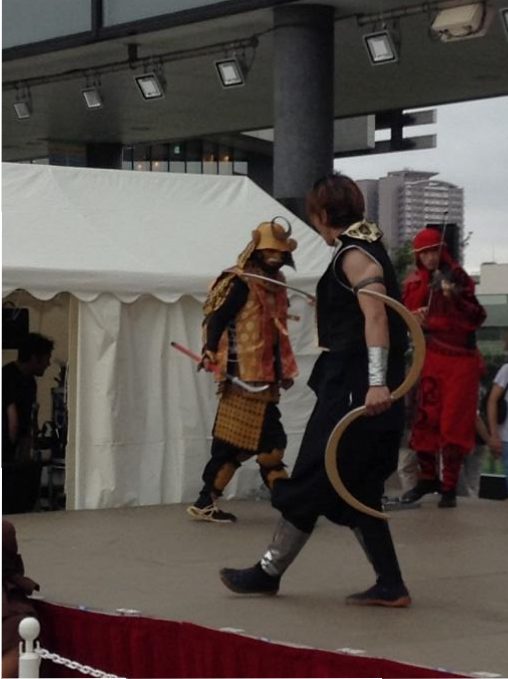
The skills of the Musashi clan can’t be underestimated. You can’t just pick up crescent blades and start swinging unless you know what you’re doing. And the samurai general was definitely emanating the spirt of Edo with is long sword and naginata halberd.
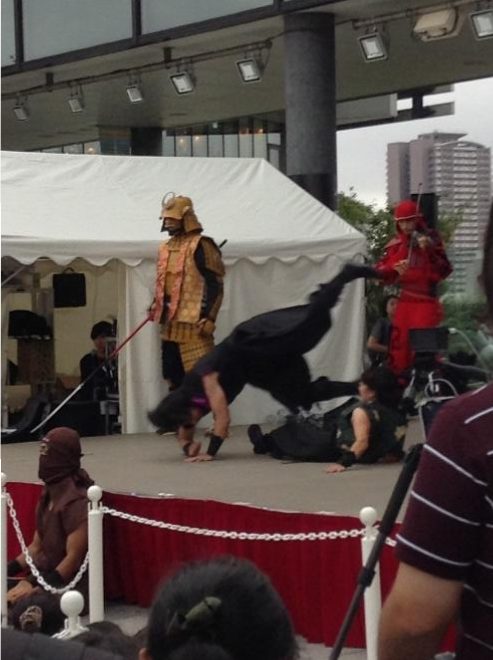
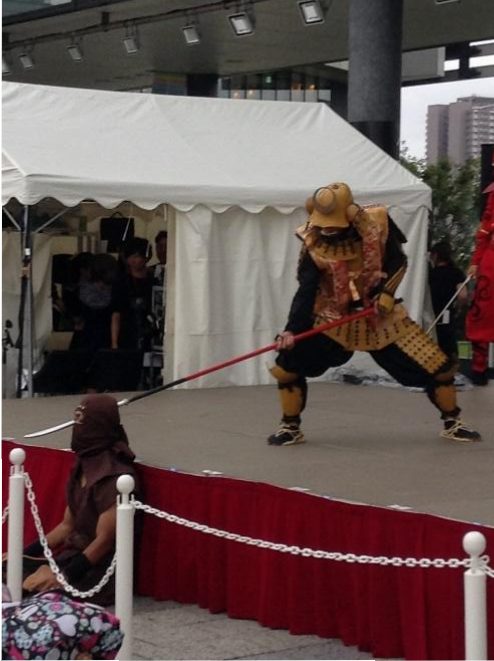
Other Ninja Groups in Japan
The other groups to perform included:
- The Tokugawa Ieyasu and Hanzo Hattori Ninja Group
- The Hizen Yume Kaido Hagakure Clan from Saga Prefecture in Kyushu
- Kawakami Jinichi and Kiyomoto Yasushi from Mie Prefecture
For those who don’t know, an appearance by the latter two is a big deal. Kawakami Jinichi is the current head of the Banke Shinobi no Den, honorary director of the Iga-ryu Ninja Museum, and the surviving representative of the Koga Ban family. Kiyomoto Yasushi belongs to the Iga ninja. Meanwhile, many will know the name Hizen Yume Kaido as the name of a theme park. The Ninja Village found in the amusement zone is based off of Edo period Ureshino. The much talked about “Apple Ninja” from the Saga Ninja Village made a special appearance at the Skytree Festival too.
Ninja Information Stalls – for events around Japan
There were also stalls set up with information about different ninja experiences and cultural events around Japan. I was very happy to see a stall for the Iga Ninja representatives there.
![Informational Stalls [Credit: Japan Ninja Council]](https://wayofninja.com/wp-content/uploads/2016/10/image02.jpg)
![Informational Stalls [Credit: Japan Ninja Council]](https://wayofninja.com/wp-content/uploads/2016/10/image03.jpg)
When I inquired about different places to train as an Iga ninja, for those with limited understanding of Japanese, I was told about the Iga City Ninja Museum and the Sato Village Forest excursion. Both of these are located in Mie Prefecture, a little farther than I am capable of going for right now. However, both of these are about 3 hours and extremely hands-on. Plus, they’re outside and deal with movement through obstacle courses. Definitely sounds like the ultimate one day learning experience. For those who are curious, Iga usually has its own Ninja Festival in the springtime.
Joining the Japan Ninja Council

I enlisted as a member of the Japan Ninja Council as well on the 27th, receiving a Katayaki and a pamphlet detailing ninja history.
A Katayaki, which translated into “hard bake,” is a rock hard ration that ninja would carry with them on long missions. The biscuit was so dense that the advice before attempting to eat it was to smash it with a hammer. When I heard that, my first thought was that, were I a ninja, I’d smash it over someone’s head first.
When the rain stopped, there were shuriken and blow gun demonstrations for the kids and some history for the adults. After that, there was a brief Q&A session that enabled the performers and clan heads to discuss topics about what the ninja did in the past and how they behave in today’s society.
Final Thoughts about Ninja Festival 2016 at Tokyo Skytree

All around, despite the rain, I think it was a marvelous way for the ninja clans to interact with the public. Believe it or not, these groups came from all over Japan to prove a point: that if you know where to look, the ninja are very much alive and still very active. I don’t know how many of them continue with espionage, but the creed that developed ninjutsu and the onmitsu continues to thrive.
Looking to find out about more Japan Ninja Council festivals? Check out the website.
Editor’s Note: This is a travel report to the Ninja Festival at Skytree organised by the Japan Ninja Council (a predominantly tourism-related organisation). Hence, the use of “ninja”, “ninjutsu” and “samurai” does not necessarily correspond to the historical use of these words.
Also, Musashi clan has no relation to Miyamoto Musashi (famous samurai). The name of their clan corresponds to the geographic province of Musashi, feudal Japan.

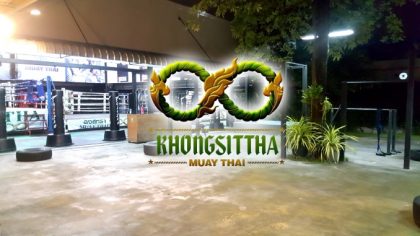
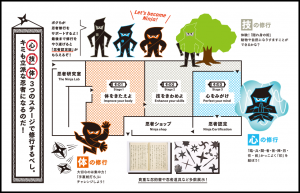
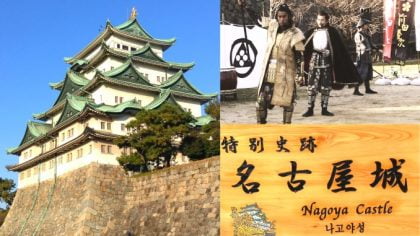

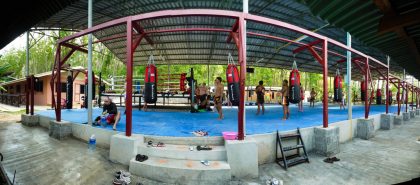
![Training At The Ninja Club Shinjuku Gym [Travel Experience]](https://www.wayofninja.com/wp-content/uploads/2016/09/ninja-gym-shinjuku-valerie-featured-420x238.jpg)